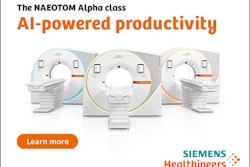A convolutional neural network (CNN) model used with a one-inhalation lung CT scan protocol can effectively diagnose and stage chronic obstructive pulmonary disease (COPD), researchers have reported.
The study findings could help reduce patient exposure to radiation and improve accessibility to CT-based severity assessment, wrote a team of researchers that included PhD candidate Amanda Lee of San Diego State University; Albert Hsiao, MD, PhD, of the University of California, San Diego; and lead author Kyle Hasenstab, PhD, also of San Diego State. The group's results were published December 12 in Radiology: Cardiothoracic Imaging.
"Although many imaging protocols for COPD diagnosis and staging require two CT acquisitions, our study shows that COPD diagnosis and staging is feasible with a single CT acquisition and relevant clinical data," Hasenstab said in a statement released by the RSNA.
The World Health Organization lists COPD as the third leading cause of death around the world. The disease consists of a group of progressive lung conditions that obstruct an individual's ability to breathe. It is typically diagnosed by a spirometry test, which assesses lung function by measuring the quantity of air that a person can inhale and exhale as well as the speed of exhalation.
CT is also used to diagnose COPD, and it requires two image acquisitions, inspiratory and expiratory. But some hospitals can't easily carry out expiratory CT protocols due to added training requirements, and elderly patients may have difficulty holding their breath during an expiratory CT exam, according to Hasenstab.
Lee and colleagues explored whether a single inhalation CT exam -- combined with use of a convolutional neural network to analyze and classify the images -- could be a viable way to diagnose and stage COPD. The group conducted a study that included inhalation and exhalation lung CT images and spirometry data from exams performed November 2007 to April 2011 in 8,893 patients. The average age of study participants was 59 years, and all had a history of smoking.
The investigators trained the CNN to predict spirometry measurements using clinical data and either a single-phase or multiphase lung CT. They then used these measurements to predict COPD severity via the Global Initiative for Obstruct Lung Disease (GOLD) stage (which consists of a scale of 1 to 4, with 1 equal to mild disease and 4 equal to "very severe").
The study found that the CNN model developed using a single respiratory phase CT image accurately diagnosed COPD -- and was also accurate within one GOLD stage. When patient clinical data was added to the model, the CNN model's predictions were even more accurate, they said.
The findings indicate that using a single inspiratory CT acquisition could offer many benefits to patients, according to Hasenstab.
"Reduction to a single inspiratory CT acquisition can increase accessibility to this diagnostic approach while reducing patient cost, discomfort, and exposure to ionizing radiation," he said.
The complete study can be found here.




















